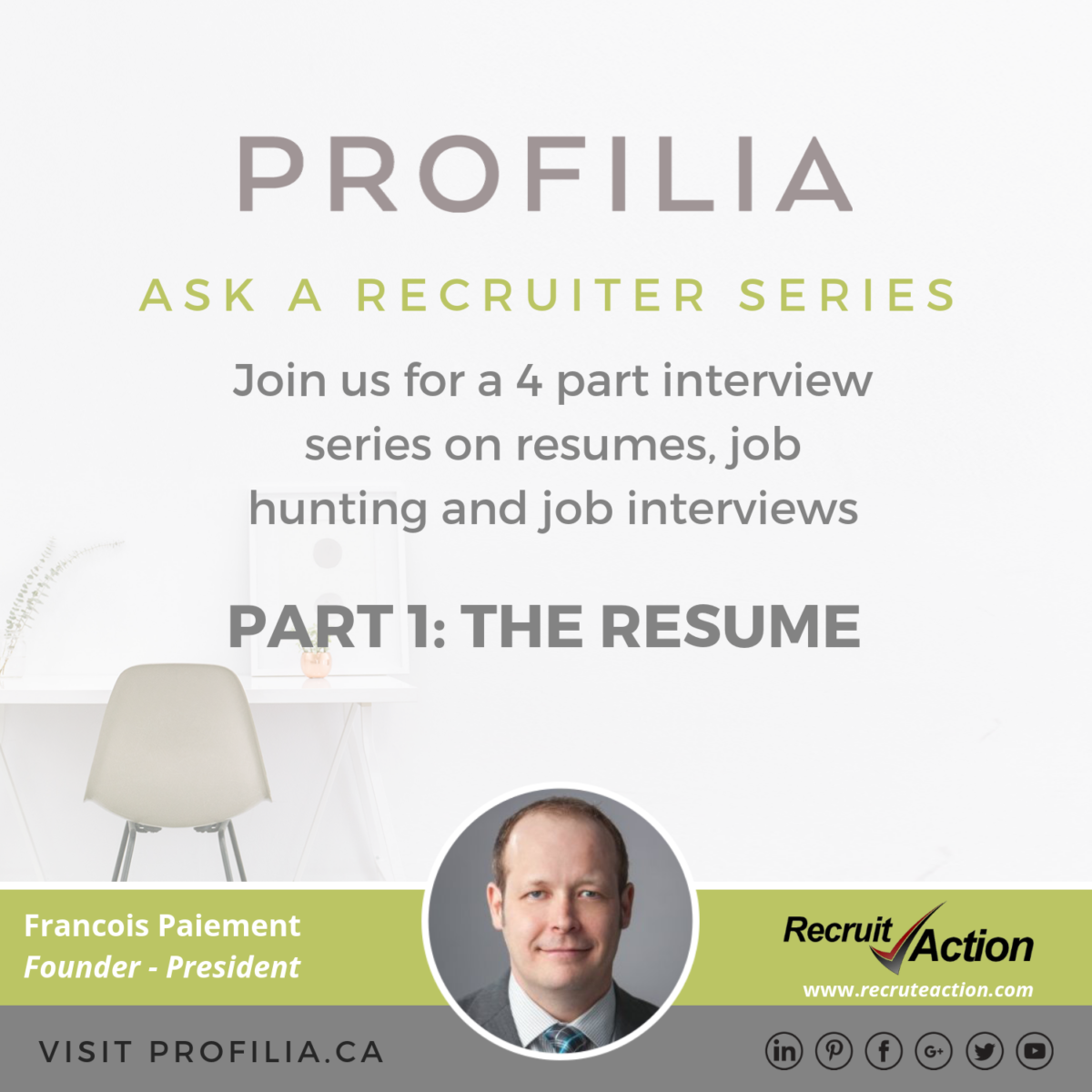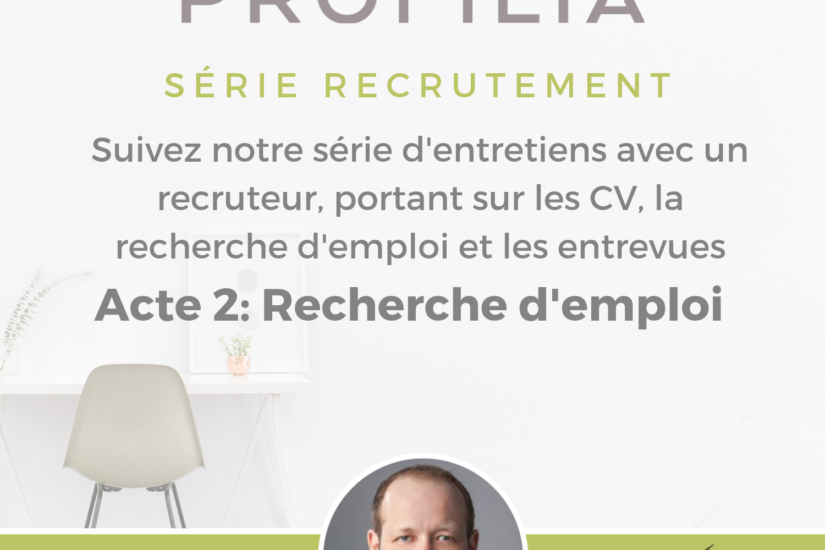Founder and President of the Montreal based recruiting agency Recrute Action. Francois Paiement has been a trusted recruiter for the past 15 years and has worked with large and small corporations alike. Since 2009, his agency’s recruiting operations are specialized in IT, marketing, sales, finance, administration, management and customer service. He represents clients across Canada, with over 120 consultants working onsite for various clients.
The Profilia team interviewed Mr. Paiement to present you a four-part series on hot topics such as optimizing your resume, job hunting and job interviews. Although different types of recruiters may have various perspectives on the topics in question, we hope to shed some light on some of the most common questions, as well as generate inspiration for your 2019 job hunt.
PART ONE – THE RESUME
1. What do you, recruiting firms and hiring managers first look at on a resume? How quickly do you scan it to get a first yes/no impression?
This question is somewhat tricky, since its answer depends on different factors:
• Who is reviewing the resume? (HR, Hiring manager, recruiter)
• Are they looking at the resume for a specific role, or on a general basis?
• If a specific role, is it for a contract or permanent role?
Personally, what I first look at on a resume will cover a few things: I will want to verify if the candidate’s experience can interest one of our clients; The companies the person worked for, the titles they had, the longevity they have worked at an employer. This gives me an idea of the profile, to then decide to either review the resume in more detail or not. My approach is focused on wanting to help the candidate and place them in the right working environment, and in the right role. My perspective is non-transactional. I want to help match their skills with the ones my clients are looking for, which can vary widely in scope across industries. Because of this, I will take a little bit more time to review what the candidate is offering as value, while maintaining a long-term vision.
When applying or working with a recruiting firm or agency, it is important to keep in mind that we don’t find jobs for people, but rather find people for jobs. As much as we would like to find a job for everyone, if we don’t have a client that could be interested in that type of profile, we will move on to the next resume. As an example, our firm does not work on industrial or engineering role mandates, so unfortunately, we would not be able to help such a candidate find their next job.
For corporate recruiters, the approach is different, since they are filtering through tons of applicants at once, specifically searching for candidates aligned with the company’s values and open roles. In doing so, they are eliminating most candidates in the pool, only picking a select few for consideration. That said, the window to make a great first impression to them is much shorter. Realistically, it is no longer than a few seconds. I would say, on average a recruiter or hiring manager will spend 10 seconds the first time they look at a resume, so it is very important to catch their attention quickly.
At the end of the day, the purpose of a resume is to get a phone interview. When updating your resume for a specific job, keep in mind that MANY people will be applying as well, so it’s important to stand out.
2. How can a candidate catch your eye?
Be concrete and give facts to sell yourself! Needless to say though, align your content to the job you are applying for, carefully selecting key words that reflect the candidate we are recruiting for. Put the key words in BOLD, highlighting what the recruiter or hiring manager is looking for, to catch their attention quickly. Place the relevant experience at the top of the list of the responsibilities you held in each job.
3. Do you look at candidate LinkedIn profiles? Other social media?
Absolutely! LinkedIn is a major source of information for recruiters, and we will certainly look you up while evaluating our interest in the candidate profile.
One of the things I am looking for, somewhat as an initial filter, are inconsistencies between the resume we received and the LinkedIn content. Make sure that they are both congruent, and that your key message carries over.
We can also refer to other social media profiles, like Facebook for example. Be mindful of what you share in public posts, and of the first impressions it can leave.
Remember that LinkedIn is not just useful for companies looking at candidate profiles. Candidates should take advantage of the platform to prepare for interviews, which includes having a look at the profile of the person who will interview you. You should also go see the LinkedIn company page, which can often provide a lot of information on the company and people working there. Who knows, you might even know someone that works there already!
4. Do you read cover letters?
I can honestly say that I rarely read cover letters, although it does depend on the type of role in question. For example, if working on a role that asks for good spelling and writing, I will take a look at the letter, but only after reviewing the resume. However, many corporate HR recruiters do, as an additional candidate filter.
Regardless, I still recommend preparing a cover letter, to optimize your chances of success. In my opinion, it is better to submit one that does not get read, rather than skip it altogether and disappoint a recruiter who is expecting one.
It is also very important to tailor the cover letter to the job and company you are applying for. This does not only mean changing the name of company and title of the job in your cover letter. If you want to create a good cover letter, see it as an Elevator pitch. In a few paragraphs, explain why you would be a good fit for the role and good fit for the company. The best cover letters I’ve seen came from people who took the time to research the company and who illustrated why they were interested in the company (ex: How the mission, vision and values of the company match yours). They also illustrated, using facts, the similarities between their previous jobs and the job they were applying for.
5. What are your thoughts on creative resume templates? The use of photos?
First, let’s remember that if the right information is not there, or if it the content does not answer the right questions, then the resume design is irrelevant! That said, creative resumes can be fun, granted they fit the role and industry expectations. They can also make the resume stand out when a hiring manager is going through MANY applications.
As for photos, I don’t see a need for them on a resume. However, they are very important on LinkedIn profiles, which serves as a complementary channel to the resume.
6. Do you use an ATS system? What are your thoughts on these?
In a nutshell, an ATS system (Applicant Tracking System) is a software companies use for managing their applications, enter data, and document notes on candidates. On a second internal level, it is also used as a candidate repository database for recruiters and hiring managers, which means that it can be referred to for future recruiting mandates as well. It also helps companies keep track of the interactions with candidates; if they have applied previously for another job, if they had a previous interview and for which job, etc..
Yes, our agency certainly uses an ATS system, especially as a candidate follow up tool. To make sure that you are properly identified and that your profile comes up for the most relevant opportunities, include the proper key words in your resume, and repeat them strategically in the content.





